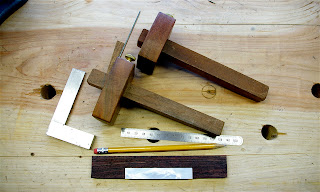Handmade Marking Gauges and Making a Copy of a 1933 Santos Hernandez Classical Guitar Bridge
Ours is really a simple craft.
James Krenov, The Impractical Cabinetmaker, 1979

I took this photo a while ago, that is one problem with having a day job, it gets in the way of what you really want to do. A day job is there to pay bills.
The top gauge I made a little over 20 years ago from some Claro walnut that my neighbor, who was a logger, gave me from a claro walnut tree that he had fallen along Cottonwood Creek in northern California. The tree had been cut up for firewood. I got the idea for the gauge from an article in a Woodwork magazine where the author made a gauge from madrone.
The lower gauge, which is really a cutting gauge, is also made from walnut, but the wood came from a tree that my grandfather planted in 1942.
I am always grateful that I made my own gauges, that I never had to buy one. There is something about using a tool that you made for yourself. Click here for an article that I recommend on how to make your own marking gauge.
I've finished shaping the wings on the bridge and tomorrow I will reduce the height of the chordal block (the part of the bridge that anchors the strings) so I can glue on a piece of mother of pearl. In an article in American Lutherie, guitar maker R.E. Brune stated that if you are making a close copy of a guitar by Antonio Torres or Hermann Hauser, and if you want it to sound as close to the original guitar, you need to make an exact copy of the original bridge. I made this bridge according to Roy Courtnall's plans, but because Julia's guitar is narrower than the original, I made the bridge shorter than the original one. I am also trying to keep this bridge as light as possible, right now it is at 20 grams, the mother of pearl will add some weight. A bridge can "dampen" a guitar top, the idea is to let the top vibrate a freely as possible. Check out this article by Ervin Somogyi on guitar dynamics.
It's been a magical experience making this guitar for Julia: the wood is amazing, adhering to the traditional Spanish school of guitar making to assemble this guitar, the French polish and the joy of working I believe are going to make this guitar truly amazing to play and to listen to.
James Krenov, The Impractical Cabinetmaker, 1979

I took this photo a while ago, that is one problem with having a day job, it gets in the way of what you really want to do. A day job is there to pay bills.
The top gauge I made a little over 20 years ago from some Claro walnut that my neighbor, who was a logger, gave me from a claro walnut tree that he had fallen along Cottonwood Creek in northern California. The tree had been cut up for firewood. I got the idea for the gauge from an article in a Woodwork magazine where the author made a gauge from madrone.
The lower gauge, which is really a cutting gauge, is also made from walnut, but the wood came from a tree that my grandfather planted in 1942.
I am always grateful that I made my own gauges, that I never had to buy one. There is something about using a tool that you made for yourself. Click here for an article that I recommend on how to make your own marking gauge.
I've finished shaping the wings on the bridge and tomorrow I will reduce the height of the chordal block (the part of the bridge that anchors the strings) so I can glue on a piece of mother of pearl. In an article in American Lutherie, guitar maker R.E. Brune stated that if you are making a close copy of a guitar by Antonio Torres or Hermann Hauser, and if you want it to sound as close to the original guitar, you need to make an exact copy of the original bridge. I made this bridge according to Roy Courtnall's plans, but because Julia's guitar is narrower than the original, I made the bridge shorter than the original one. I am also trying to keep this bridge as light as possible, right now it is at 20 grams, the mother of pearl will add some weight. A bridge can "dampen" a guitar top, the idea is to let the top vibrate a freely as possible. Check out this article by Ervin Somogyi on guitar dynamics.
It's been a magical experience making this guitar for Julia: the wood is amazing, adhering to the traditional Spanish school of guitar making to assemble this guitar, the French polish and the joy of working I believe are going to make this guitar truly amazing to play and to listen to.


Neat marking gauges Wilson, and thanks for that link which I have marked for reading later - looks useful.
ReplyDeleteThat's interesting about the bridge affecting the vibration of the top. You put such a lot of thought into your work.
Thanks for the comment, Rob!
ReplyDeleteI do try to do more than some research on guitar acoustics, anything to help me build a better guitar!